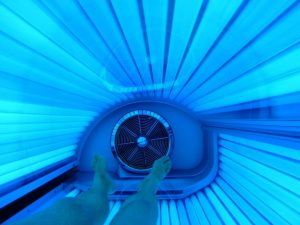Despite strong evidence of carcinogenicity, despite increasing skin cancer rates, and despite harrowing stories of young people dying, the US lags behind many countries in the regulation of tanning beds. At a minimum, federal and state governments should ban the use of tanning beds by minors in the United States. In their 2014 review of the effectiveness of existing state indoor tanning laws, Guy et al confirm that “age restrictions, in particular, may be effective in reducing indoor tanning among female high school students.” This supports Mayer et al’s 2011 findings that bans (as opposed to less stringent requirements such as parental consent) are the most effective way to reduce high rates of indoor tanning among adolescent girls.

Even more effective in protecting our youth, and all Americans, would be a population wide ban on commercial tanning beds. Population wide bans, like those in Brazil and the majority of Australian states, leave no room for lax enforcement of minimum age requirements, parental consent, and other restrictions.
Indoor tanning laws across the globe
France was the first country to ban tanning among minors in 1997. Brazil followed France’s lead in 2002, and became the first country in the world to ban tanning for cosmetic purposes across its entire population. As of January 1st, 2015, commercial tanning beds are banned in six of eight Australian states and territories. A growing number of European countries have banned indoor tanning among minors, including Spain, Germany, Belgium, the United Kingdom, and Austria.
Indoor tanning laws in the United States
Though many US states are moving to ban the use of tanning beds by minors, and stronger US Food and Drug Administration (FDA) warning requirements will take effect next year, the US lags behind other countries in the regulation of tanning beds.
Nine US states (Alaska, Colorado, Idaho, Iowa, Kansas, Montana, New Mexico, Oklahoma, and South Dakota) do not regulate the use of tanning beds (including by minors). Twenty-six states (and the District of Columbia) restrict the use of commercial tanning devices by minors, requiring, for example, in person parental consent, or a signed permission slip. Fifteen US states (California, Connecticut, Delaware, Hawaii, Illinois, Louisiana, Minnesota, Nevada, Oregon, Rhode Island, Texas, Utah, Vermont, Washington, and West Virginia) have banned the use of commercial tanning devices by persons under 18 years (though in some of these states the prohibition may be lifted if use is prescribed by a physician).
In 2014, the FDA issued a final order reclassifying indoor tanning equipment (such as sunlamps and ultraviolet lamps) from low-risk to moderate-risk, and requiring visible black-box warnings on each device stating that they should not be used by persons under 18 years. The warning requirements will take effect in August, 2015. Currently, 33 states have laws requiring facilities with tanning beds to post warnings.
Indoor tanning increases the risk of skin cancer
The WHO’s International Agency for Research on Cancer classifies UV-emitting tanning devices as Group 1: carcinogenic to humans.
Wehner et al estimate that approximately 400,000 cases of skin cancer in the United States each year are attributable to indoor tanning. Indoor tanning increases the risk of developing squamous cell carcinoma, basal cell carcinoma, and melanoma, which account for over 99% of skin cancers.
The risk of developing skin cancer is higher among younger and more frequent users of indoor tanning beds. A meta-analysis of studies conducted since 2000 shows that individuals who have ever indoor tanned have a 22% higher risk of developing melanoma, which is now the third most common cancer diagnosed among young people aged 15-39 years in the United States. Those who indoor tan before age 35 have a 59% higher risk of developing melanoma compared to those who commence indoor tanning after age 35.
In addition to detrimental health consequences, indoor tanning contributes to the estimated $1.7 billion annual cost of treating skin cancer in the United States.
Indoor tanning is not safer than tanning outdoors
There is no evidence to suggest that indoor tanning is safer than tanning through sun exposure. According to the American Cancer Society, “[i]ndoor tanning is just as dangerous, if not more, than tanning outside in the sun.” Studies show that the average intensity of artificial UV radiation corresponds to a UV Index of 13-14 (extreme).
Teenagers and “tanning”
In her recent New York Times article “Warning: That Tan Could Be Hazardous”, Sabrina Tavernise laments that indoor tanning remains “a persistent part of American adolescence.” The article provides some startling information. In Florida, for example, “there are more tanning salons than McDonald’s restaurants, CVS stores or Bank of America branches,” and “[a]bout half the country’s top 125 colleges have tanning beds on campus or in off-campus housing.”
Although messaging, knowledge, and understanding about the risks of indoor tanning (and excessive sun exposure) have increased in recent years, many people still associate a tan with good health, fitness, and attractiveness. Tanning can give us a “healthy glow,” and allow us to achieve a “protective” base tan. Social pressures to conform, especially media representations of young women, drive us to tan despite increasing knowledge and understanding of the risks.
Laws banning or restricting use of sunbeds can minimize, if not end, a dangerous, carcinogenic practice. Restricting or banning tanning beds may also help change social norms around the desirability of a tan. Such laws would help decrease the number of people tanning, challenging the notion of a tanned body as the ideal body. Such laws would also help negate the misconception that tanning beds must be safe because the government permits adults, and in some cases minors, to use them.
Indoor tanning is a completely avoidable source of ultraviolet radiation, and should not be part of American adolescence. It is time to ban indoor tanning in the United States, to protect our youth, and to help shatter the myth than tanned skin is healthy skin.



